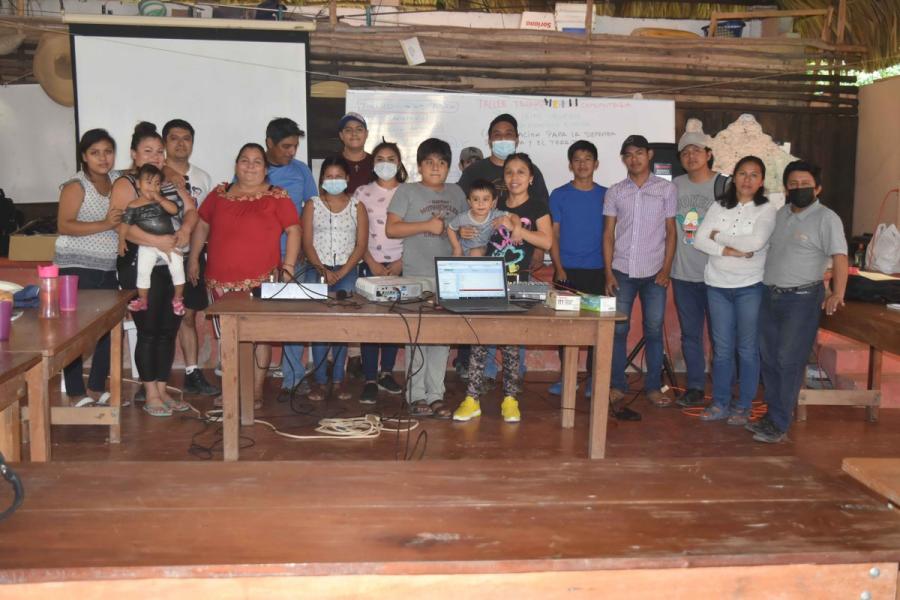Juanita Chepe wakes up early to make breakfast for Antonia, her 84-year-old mother, before beginning her 45-minute walk and bus ride to her job in the neighboring town of Cuetzalan. Along with 70 other Nahua families, Juanita and her mother live in Chicueyaco, a small, mountainous village three hours North of Peubla, Mexico.
The Nahua people’s language—Nahuatl—is the language of the Aztecs, Toltcec, and others. (The words avocado, tomato, chili, coyote, and chocolate have Nahuatl roots.) Today Nahuatl—with approximately 1.4 million speakers—is the most widely spoken Indigenous language in Mexico. An estimated 190,000 of those people speak only Nahuatl. Here in the region of Cuetzalan, the Nahua remain the dominant ethnic group in terms of population and have been largely successful in both adapting to the modern economy and maintaining their culture.
Juanita walks up a rocky path through the coffee trees and underbrush with occasional vistas of the green mountains and valleys beyond. Many days the clouds fill in the valleys, obscuring the view and providing a misty rain. Juanita walks past the schoolyard and Chicueyaco’s stone church to the road that stops at the edge of her village and continues her climb. At the top of the hill, she waits for the white combi, or minivan, for the 15-minute ride into town.
Juanita manages an eco-lodge called Hotel Taselotzin on a hill overlooking Cuetzalan. When she and 44 other women from five Nahua communities near Cuetzalan were having difficulty supporting their families by selling their traditional weaving and stitching, they managed to get funding from the Mexican government and international and national organizations to build the hotel. The women each invested their own money and labor in the hotel as well. In exchange for their work at the hotel, they receive food, clothing, and soap for their families.
The women take what they need and share the rest as necessary with the community: Nahua society maintains a strong sense of cooperation. Most of the men tend to each family’s farm plots, growing crops like potatoes, mushrooms, and peppers. Each family also harvests coffee from its own trees both for home use and for sale in town or to a coffee cooperative. Although agriculture remains the primary source of income, the in-kind earnings from the hotel have a significant impact on a family’s well-being, even more so for unmarried women like Juanita. In this still-lightly touristed region, manufacturing and sales of stitched crafts have not displaced agriculture.
Hotel Taselotzin caters primarily to urban Mexican clientele seeking an escape from city life, who enjoy the packed market days on Cuetzalan’s cobblestone streets and nearby caves, Totonac ruins, a waterfall, and a swimming hole. The lush gardens on the hotel grounds grow herbs for the restaurant's menu, rose petals for the soap made on site, and orange blossoms for tea. A Nahua woman elder runs the sweat lodge. Antonio, the husband of the soap-maker, runs the spa and doubles as watchman and gardener. Staff are careful to recycle goods and separate organic and inorganic waste, to lessen their impact on the land. Each semester the lodge receives University of Mexico interns who are studying Indigenous Peoples, sustainable tourism, and economic development.
Today Juanita leaves the hotel early, since there is work to do in Chicueyaco at the health center that enables people to get some health care directly in their own community. The white health center, which was built by the community, stands in a clearing on land donated by one villager. For a number of years, the clinic has provided prenatal care, vaccinations, screenings, and other minor procedures with some funding and support from the Global Citizens Network, an NGO from the United States. This week, the work focuses on building a bathroom and a patio.
The patio will double both as a waiting room and a needed community gathering space. The bathroom will make the health center more attractive to potential nurses and doctors—and their patients. Everyone does their part moving piles of sand and gravel down the steep path to the health center, one bag-full at a time. They also mix concrete and build the patio and bathroom walls. This self-sufficient community works together to provide a practical service that makes it easier for people to stay in their village—and preserve their Nahua way of life.
At the end of the day, Juanita hurries home so she can catch a soap opera with her mother, Antonia. Although Antonia speaks only Nahuatl, not Spanish, she loves the Mexican soap operas anyway. Tonight, Juanita and Antonia can laugh together at the crazy soap opera fights.
Jennifer Larson is a graphic designer, photographer, and children's book author who lives in Minneapolis, Minnesota, with her husband and two kids. She traveled to Chicueyaco, Mexico, with Global Citizens Network, a nonprofit organization that, since 1992, has been advocating for Indigenous communities and providing cultural immersion experiences.




